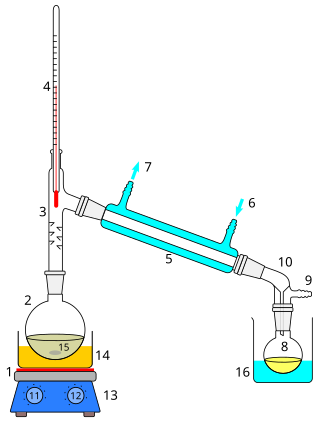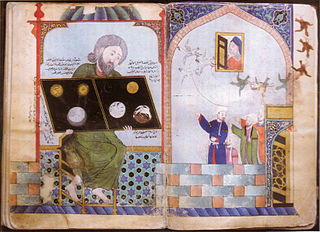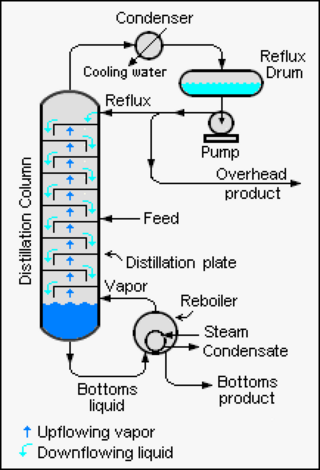
An alembic (from Arabic : الإنبيق, romanized: al-inbīq, originating from Ancient Greek : ἄμβιξ, romanized: ambix, 'cup, beaker') [1] [2] [3] is an alchemical still consisting of two vessels connected by a tube, used for distillation of liquids.

An alembic (from Arabic : الإنبيق, romanized: al-inbīq, originating from Ancient Greek : ἄμβιξ, romanized: ambix, 'cup, beaker') [1] [2] [3] is an alchemical still consisting of two vessels connected by a tube, used for distillation of liquids.
The complete distilling apparatus consists of three parts:
In the case of another distilling vessel, the retort, the "cap" and the "cucurbit" have been combined to form a single vessel. The anbik [4] is also called the raʾs (the Arabic word raʾs means "head") of the cucurbit. The liquid in the cucurbit is heated or boiled; the vapour rises into the anbik, where it cools by contact with the walls and condenses, running down the spout into the receiver. A modern descendant of the alembic is the pot still, used to produce distilled beverages.

Dioscorides's ambix, described in his De materia medica (c. 50 C.E.), is a helmet-shaped lid for gathering condensed mercury. For Athenaeus (c. 225 C.E.) it is a bottle or flask. For later chemists it denoted various parts of crude distillation devices.
Alembic drawings appear in works of Cleopatra the Alchemist (3rd century C.E.), Zosimos of Panopolis (c. 300 C.E.), and Synesius (c. 373 – c. 414 C.E.). There were alembics with two (dibikos) and three (tribikos) receivers. [5] According to Zosimos of Panopolis, the alembic was invented by Mary the Jewess. [6]
The anbik is described by Ibn al-Awwam in his Kitab al-Filaha (Book of Agriculture), where he explains how rose-water is distilled. Amongst others, it is mentioned in the Mafatih al-Ulum (Key of Sciences) of Khwarizmi and the Kitab al-Asrar (Book of Secrets) of al-Razi. Some illustrations occur in the Latin translations of works which are attributed to Geber. [2]
The Unicode character set specifies three symbols for alembics: the pictogram ⚗ (U+2697), its emoji variation ⚗️ (U+2697U+FE0F ), and the ancient alchemical symbol 🝪 (U+1F76A). The latter is part of the newer UCS-4 addition that includes other ideographs like emojis; web browsers that do not use UTF-16 encoding cannot display it properly.

Alchemy is an ancient branch of natural philosophy, a philosophical and protoscientific tradition that was historically practised in China, India, the Muslim world, and Europe. In its Western form, alchemy is first attested in a number of pseudepigraphical texts written in Greco-Roman Egypt during the first few centuries AD. Greek-speaking alchemists often referred to their craft as “the Art” (τέχνη) or “Knowledge” (ἐπιστήμη), and it was often characterised as mystic (μυστική), sacred (ἱɛρά), or divine (θɛíα).

Distillation, also classical distillation, is the process of separating the component substances of a liquid mixture of two or more chemically discrete substances; the separation process is realized by way of the selective boiling of the mixture and the condensation of the vapors in a still.
Fractional distillation is the separation of a mixture into its component parts, or fractions. Chemical compounds are separated by heating them to a temperature at which one or more fractions of the mixture will vaporize. It uses distillation to fractionate. Generally the component parts have boiling points that differ by less than 25 °C (45 °F) from each other under a pressure of one atmosphere. If the difference in boiling points is greater than 25 °C, a simple distillation is typically used.

A still is an apparatus used to distill liquid mixtures by heating to selectively boil and then cooling to condense the vapor. A still uses the same concepts as a basic distillation apparatus, but on a much larger scale. Stills have been used to produce perfume and medicine, water for injection (WFI) for pharmaceutical use, generally to separate and purify different chemicals, and to produce distilled beverages containing ethanol.

A pot still is a type of distillation apparatus or still used to distill liquors such as whisky or brandy. In modern (post-1850s) practice, they are not used to produce rectified spirit, because they do not separate congeners from ethanol as effectively as other distillation methods. Pot stills operate on a batch distillation basis. Traditionally constructed from copper, pot stills are made in a range of shapes and sizes depending on the quantity and style of spirit desired.
The Liebig condenser or straight condenser is a piece of laboratory equipment, specifically a condenser consisting of a straight glass tube surrounded by a water jacket.

Vitriol is the general chemical name encompassing a class of chemical compounds comprising sulfates of certain metals – originally, iron or copper. Those mineral substances were distinguished by their color, such as green vitriol for hydrated iron(II) sulfate and blue vitriol for hydrated copper(II) sulfate.

Alchemical symbols were used to denote chemical elements and compounds, as well as alchemical apparatus and processes, until the 18th century. Although notation was partly standardized, style and symbol varied between alchemists. Lüdy-Tenger published an inventory of 3,695 symbols and variants, and that was not exhaustive, omitting for example many of the symbols used by Isaac Newton. This page therefore lists only the most common symbols.

In a chemistry laboratory, a retort is a device used for distillation or dry distillation of substances. It consists of a spherical vessel with a long downward-pointing neck. The liquid to be distilled is placed in the vessel and heated. The neck acts as a condenser, allowing the vapors to condense and flow along the neck to a collection vessel placed underneath.

Steam distillation is a separation process that consists of distilling water together with other volatile and non-volatile components. The steam from the boiling water carries the vapor of the volatiles to a condenser; both are cooled and return to the liquid or solid state, while the non-volatile residues remain behind in the boiling container.

Liquor or distilled beverage is an alcoholic drink produced by the distillation of grains, fruits, vegetables, or sugar that have already gone through alcoholic fermentation. Other terms for liquor include spirit, spirituous liquor or hard liquor. The distillation process concentrates the liquid to increase its alcohol by volume. As liquors contain significantly more alcohol (ethanol) than other alcoholic drinks, they are considered "harder." In North America, the term hard liquor is sometimes used to distinguish distilled alcoholic drinks from non-distilled ones, whereas the term spirits is more commonly used in the UK. Some examples of liquors include vodka, rum, gin, and tequila. Liquors are often aged in barrels, such as for the production of brandy and whiskey, or are infused with flavorings to form flavored liquors, such as absinthe.

Mary or Maria the Jewess, also known as Mary the Prophetess or Maria the Copt, was an early alchemist known from the works of Zosimos of Panopolis and other authors in the Greek alchemical tradition. On the basis of Zosimos's comments, she lived between the first and third centuries A.D. in Alexandria. French, Taylor and Lippmann list her as one of the first alchemical writers, dating her works at no later than the first century.
Mu'ayyad al-Din Abu Isma'il al-Husayn ibn Ali ibn Muhammad ibn Abd al-Samad al-Du'ali al-Kināni al-Tughra'i was a poet and alchemist.

Zosimos of Panopolis was an alchemist and Gnostic mystic. He was born in Panopolis, and likely flourished ca. 300. He wrote the oldest known books on alchemy, which he called "Cheirokmeta," using the Greek word for "things made by hand." Pieces of this work survive in the original Greek language and in translations into Syriac or Arabic. He is one of about 40 authors represented in a compendium of alchemical writings that was probably put together in Constantinople in the 7th or 8th century AD, copies of which exist in manuscripts in Venice and Paris. Stephen of Alexandria is another.

In pre-modern chemistry and alchemy, cohobation was the process of repeated distillation of the same matter, with the liquid drawn from it ; that liquid being poured again and again upon the matter left at the bottom of the vessel. Cohobation is a kind of circulation, only differing from it in this, that the liquid is drawn off in cohobation, as in common distillation, and thrown back again; whereas in circulation, it rises and falls in the same vessel, without ever being drawn out.
Batch distillation refers to the use of distillation in batches, meaning that a mixture is distilled to separate it into its component fractions before the distillation still is again charged with more mixture and the process is repeated. This is in contrast with continuous distillation where the feedstock is added and the distillate drawn off without interruption. Batch distillation has always been an important part of the production of seasonal, or low capacity and high-purity chemicals. It is a very frequent separation process in the pharmaceutical industry.

Muḥammad ibn Umayl al-Tamīmī, known in Latin as Senior Zadith, was an early Muslim alchemist who lived from c. 900 to c. 960 AD.

Reflux is a technique involving the condensation of vapors and the return of this condensate to the system from which it originated. It is used in industrial and laboratory distillations. It is also used in chemistry to supply energy to reactions over a long period of time.
The following outline is provided as an overview of and topical guide to alchemy:

Cleopatra the Alchemist was a Greek alchemist, writer, and philosopher. She experimented with practical alchemy but is also credited as one of the four female alchemists who could produce the philosopher's stone. Some writers consider her to be the inventor of the alembic, a distillation apparatus.